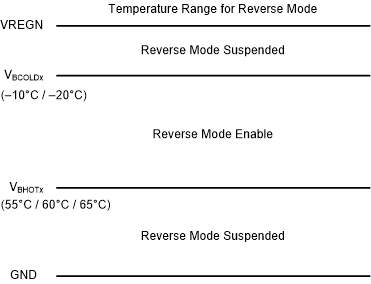SLUSFH5A May 2024 – October 2024 BQ25856-Q1
PRODUCTION DATA
- 1
- 1 Features
- 2 Applications
- 3 Description
- 4 Device Comparison
- 5 Pin Configuration and Functions
- 6 Specifications
-
7 Detailed Description
- 7.1 Overview
- 7.2 Functional Block Diagram
- 7.3
Feature Description
- 7.3.1 Device Power-On-Reset
- 7.3.2 Device Power-Up From Battery Without Input Source
- 7.3.3 Device Power Up From Input Source
- 7.3.4 Battery Charging Management
- 7.3.5 Power Management
- 7.3.6 Switching Frequency Dithering Feature
- 7.3.7 Reverse Mode Power Direction
- 7.3.8 Integrated 16-Bit ADC for Monitoring
- 7.3.9 Status Outputs (PG, STAT1, STAT2, and INT)
- 7.3.10
Protections
- 7.3.10.1
Voltage and Current Monitoring
- 7.3.10.1.1 VAC Over-voltage Protection (VAC_OVP)
- 7.3.10.1.2 VAC Under-voltage Protection (VAC_UVP)
- 7.3.10.1.3 Battery Over-voltage Protection (BAT_OVP)
- 7.3.10.1.4 Battery Over-current Protection (BAT_OCP)
- 7.3.10.1.5 Reverse Mode Over-voltage Protection (REV_OVP)
- 7.3.10.1.6 Reverse Mode Under-voltage Protection (REV_UVP)
- 7.3.10.1.7 DRV_SUP Under-voltage and Over-voltage Protection (DRV_OKZ)
- 7.3.10.1.8 REGN Under-voltage Protection (REGN_OKZ)
- 7.3.10.2 Thermal Shutdown (TSHUT)
- 7.3.10.1
Voltage and Current Monitoring
- 7.3.11 Serial Interface
- 7.4 Device Functional Modes
- 7.5 BQ25856-Q1 Registers
-
8 Application and Implementation
- 8.1 Application Information
- 8.2
Typical Applications
- 8.2.1
Typical Application
- 8.2.1.1 Design Requirements
- 8.2.1.2
Detailed Design Procedure
- 8.2.1.2.1 ACUV / ACOV Input Voltage Operating Window Programming
- 8.2.1.2.2 Charge Voltage Selection
- 8.2.1.2.3 Switching Frequency Selection
- 8.2.1.2.4 Inductor Selection
- 8.2.1.2.5 Input (VAC) Capacitor
- 8.2.1.2.6 Output (VBAT) Capacitor
- 8.2.1.2.7 Sense Resistor (RAC_SNS and RBAT_SNS) and Current Programming
- 8.2.1.2.8 Power MOSFETs Selection
- 8.2.1.2.9 Converter Fast Transient Response
- 8.2.1.3 Application Curves
- 8.2.2 Typical Application (4s LiFePO4 car battery configuration)
- 8.2.3 Typical Application (Capacitor Backup)
- 8.2.1
Typical Application
- 9 Power Supply Recommendations
- 10Layout
- 11Device and Documentation Support
- 12Revision History
- 13Mechanical, Packaging, and Orderable Information
Package Options
Refer to the PDF data sheet for device specific package drawings
Mechanical Data (Package|Pins)
- RRV|36
Thermal pad, mechanical data (Package|Pins)
- RRV|36
Orderable Information
7.3.4.6.2 Cold/Hot Temperature Window in Reverse Mode
For battery protection during reverse or auto-reverse mode operation, the device monitors the battery temperature to be within the VBCOLD to VBHOT thresholds. When temperature is outside of the thresholds, the reverse mode is shut off. In addition, EN_REV, EN_AUTO_REV and REVERSE_STAT bits are cleared to 0 and corresponding TS_STAT is reported (TS Cold or TS Hot). The temperature protection in reverse mode can be completely disabled by clearing the EN_TS bit to 0.
 Figure 7-5 TS Pin Thermistor Sense
Threshold in Reverse Mode
Figure 7-5 TS Pin Thermistor Sense
Threshold in Reverse Mode